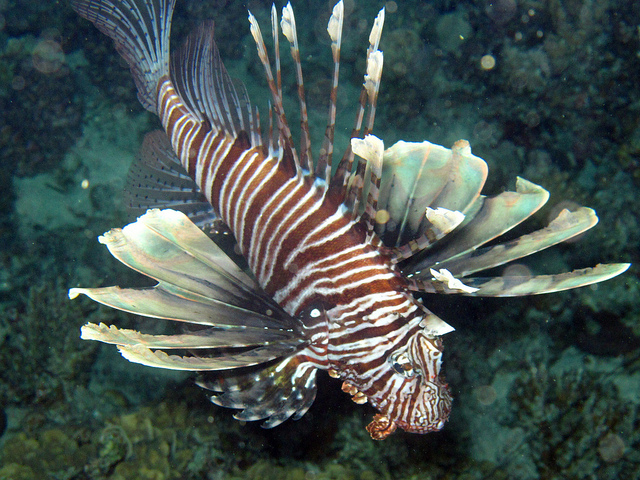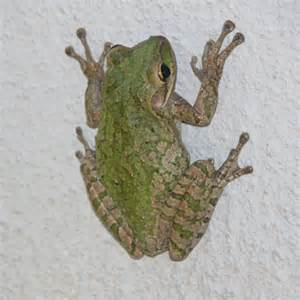There are more invasive plants issues in Escambia County than animal ones; but we do have animal invasives. Some have been with us for some time, like the feral hogs which will be posted in a different article, some are more recent. In this article we are going to focus on two species that could become real problems for us without some management plan – the lionfish and the Cuban treefrog.

The red lionfish (Pterois volitans) has been in the local news for some time – but as a Gulf of Mexico problem. The fish is from the Indo-Pacific region of the world and was brough here for the pet trade. The first records we have of it in the wild were in southeast Florida in the 1980s. We are not 100% sure how they reached the Atlantic Ocean, but they did – and they did well.
Lionfish display a courtship dance where, near sunset, the males and females rise off the reef in a rotating swimming pattern and then fertilize their eggs. On average, each female will fertilize 30,000 eggs every four days! These fertilized eggs are encased in a gelatinous sac that drifts with the currents and is a method of spreading the species across the region. Originating in southeast Florida, the Gulf Stream dispersed them north along the coasts of Georgia and the Carolina’s. From here the invasion moved east to Bermuda where the Atlantic currents cycled them back south to the Caribbean, here they invaded every reef system in the region. From the Caribbean they found there way to the Florida Keys and eventually into the Gulf of Mexico. The first record in Escambia County was in 2010. It has been described as one of the most prolific, and successful, invasions of a non-native species ever.
Studies show that the invasion in the Pensacola area was particularly bad. One study showed that the densities in our area were some of the highest in the south Atlantic region. Another study showed they had preference for artificial over natural reefs. In response, the Escambia County Division of Marine Resources, partnering with Florida Sea Grant, developed a series of local workshops to educate the public about the issue.
From these meetings nonprofits formed that began to have “rodeos” and “roundups” providing prizes to divers who could remove the most, the largest, and even the smallest lionfish. Eventually the Florida Fish and Wildlife Conservation Commission (FWC) joined in and created the Lionfish Removal and Awareness Day (LRAD). This event, which began in Pensacola, attracted thousands of curious people, chefs cooking samples, and divers from across the region. These efforts, along with an increase in commercial harvest (the fish is edible) have made a significant impact on populations in waters less than 200 feet (where divers can safely work) – but lionfish can live as deep as 1000 feet.
In 2019 a gentlemen fishing on the pier at Ft. Pickens caught one on hook and line. Charter captains have been catching them on hook and line for a few years but it was not common and usually in low numbers. Over the nine years since the first record, there had also been three records within Big Lagoon, so – finding one inside of the pass was not new, but concerning. Partnering with the Ocean Strike Team, Sea Grant conducted a series of survey dives to assess the status of lionfish near the pier and jetties of Ft. Pickens. They found them – though in small numbers, lionfish were present.
The question now is how far within the bay has this invasion spread. The concern is two things.
- Lionfish are gregarious feeders – eating just about anything they can get into their mouths. Offshore they are known to eat no fewer than 70 species of small reef fish, including the commercially important vermilion snapper, and several invertebrates, including shovel nosed lobsters. If they invade the bay, we are now looking at juvenile shrimp, blue crabs, flounder, redfish, and more. The impact could be very big.
- They are venomous. Not by bite, but by spines. Though it has not killed anyone, the “sting” of a lionfish is extremely painful and placed some in the hospital. With numerous locals and visitors swimming in our estuarine waters, encounters with this fish will occur, and problems with envenomation will follow.
The response needed from the county is to develop a management plan for this fish in our bay. Studies show that the most effective, and least costly, methods occur at the early stages of the invasion – Early Detection Rapid Response. There are several agencies, including Florida Sea Grant, ready to assist with this.

As the name implies, the Cuban treefrog (Osteopilus septentrionalis) is from Cuba – though it is native the Bahamas and the Cayman Islands as well. Records show they arrived in the Florida Keys in the 1920s – most likely “hitchhiking” on boats crossing the Florida straits.
This is a large treefrog, can reach six inches – compared to the two inches of our native frogs, and quickly moved in consuming local wildlife. As with many invasive species, their numbers increased quickly, and they became common across the landscape. In most locations where Cuban treefrogs were present, NO native frogs could be found. Studies show that in pools where Cuban treefrog tadpoles exist, no native tadpoles survive. Native frog populations began to decline. This is a large treefrog, not only do they consume native frogs, but they also consume small lizards, snakes, and all sorts of insects.
But the problem goes beyond native ecology. These treefrogs love to be around humans. Residents complain of the numbers of these large frogs on their doors and windows in the evening. They defecate making a large mess and the calls of the males sounds like a squeaky screen door keeping folks up at night – especially when they are abundant and there are no other frogs in the neighborhood. They are known to enter vent pipes in the plumbing, sometimes clogging these pipes, often appearing in your commode when you lift the lid to use the restroom. People do not like them. They are also known to hideout in electric panels and often short circuit home electrical and HVAC systems. Some of these problems become costly to the property owners.
The Cuban treefrogs have dispersed out of south Florida. They are now established as far north as Gainesville, Jacksonville, and Cedar Key. But records in the Florida panhandle, including Escambia County, are increasing.
Our part of the state was once immune to invasions of tropical species such as this frog. Our winters were cold enough to eradicate the few that made it here. We think the most frequent method of invasion is by hitchhiking – just as they originally did. Many of the landscaping plants we purchase for our homes and neighborhoods are grown at large nurseries in south Florida. These plants are loaded onto trucks and brought here – bringing Cuban treefrogs, Brown anoles, and many other small frogs and lizards that can be a problem for us. It appears that our winters are becoming milder, and these invaders are now surviving. Dr. Steve Johnson (University of Florida) has verified a breeding colony of Cuban treefrogs in Bay County. Records and calls from Escambia and Santa Rosa counties are increasing. We do not know whether these populations are breeding – but the concern is there.
Florida Sea Grant plans to develop a citizen science monitoring project in the spring of 2023 to assess the status of these frogs in our county. As with the lionfish, early detection – rapid response is the key to managing them.
If you are interested in participating in either the bay lionfish surveys, or the Cuban treefrogs surveys in Escambia County, contact Rick O’Connor at the Escambia County Extension Office.
- Tips for Bear Encounters this Fall - November 10, 2025
- Pensacola Bay Invasive Species Summer Survey 2025 - November 3, 2025
- Our Environment: Part 24 – Our Changing Climate - November 3, 2025
